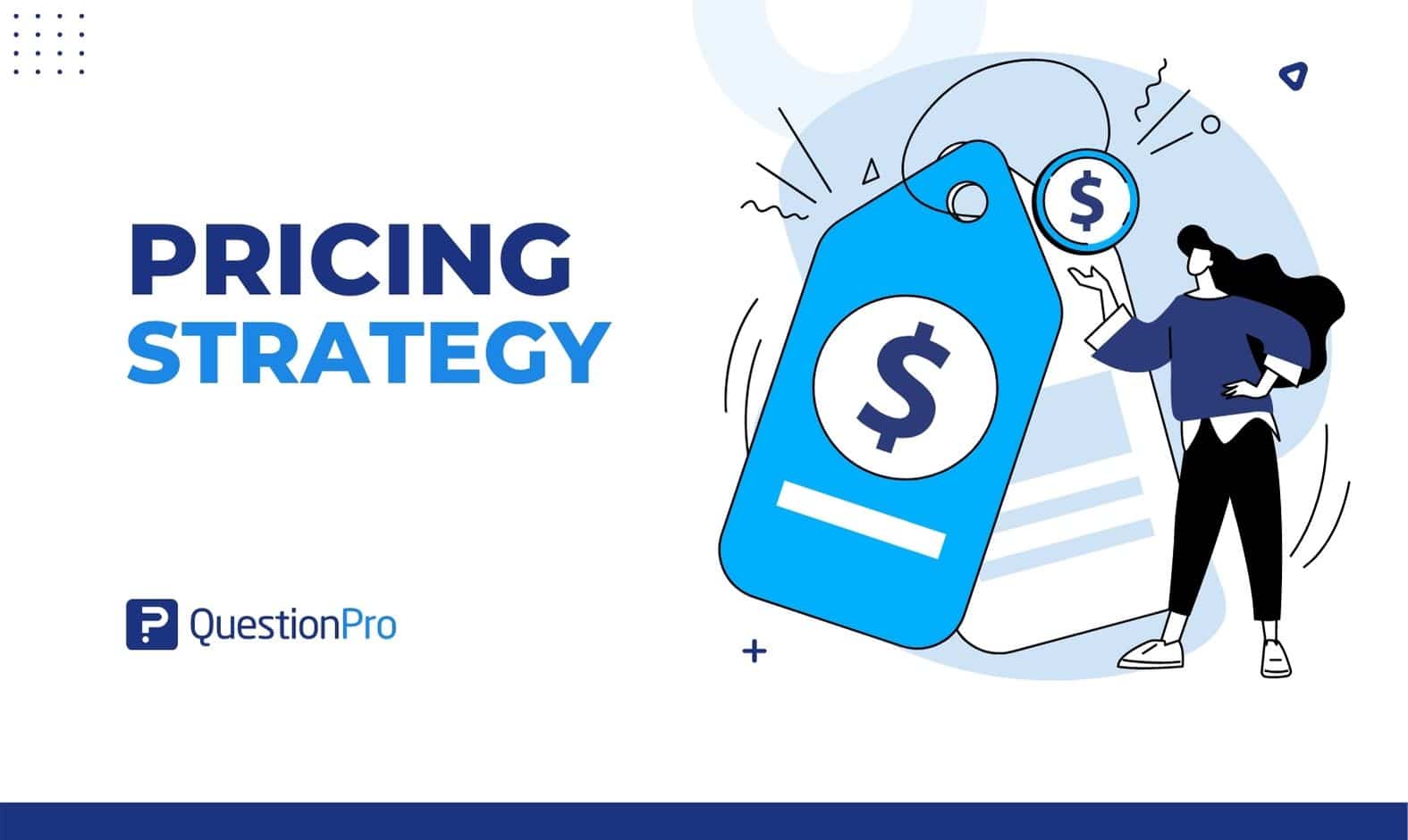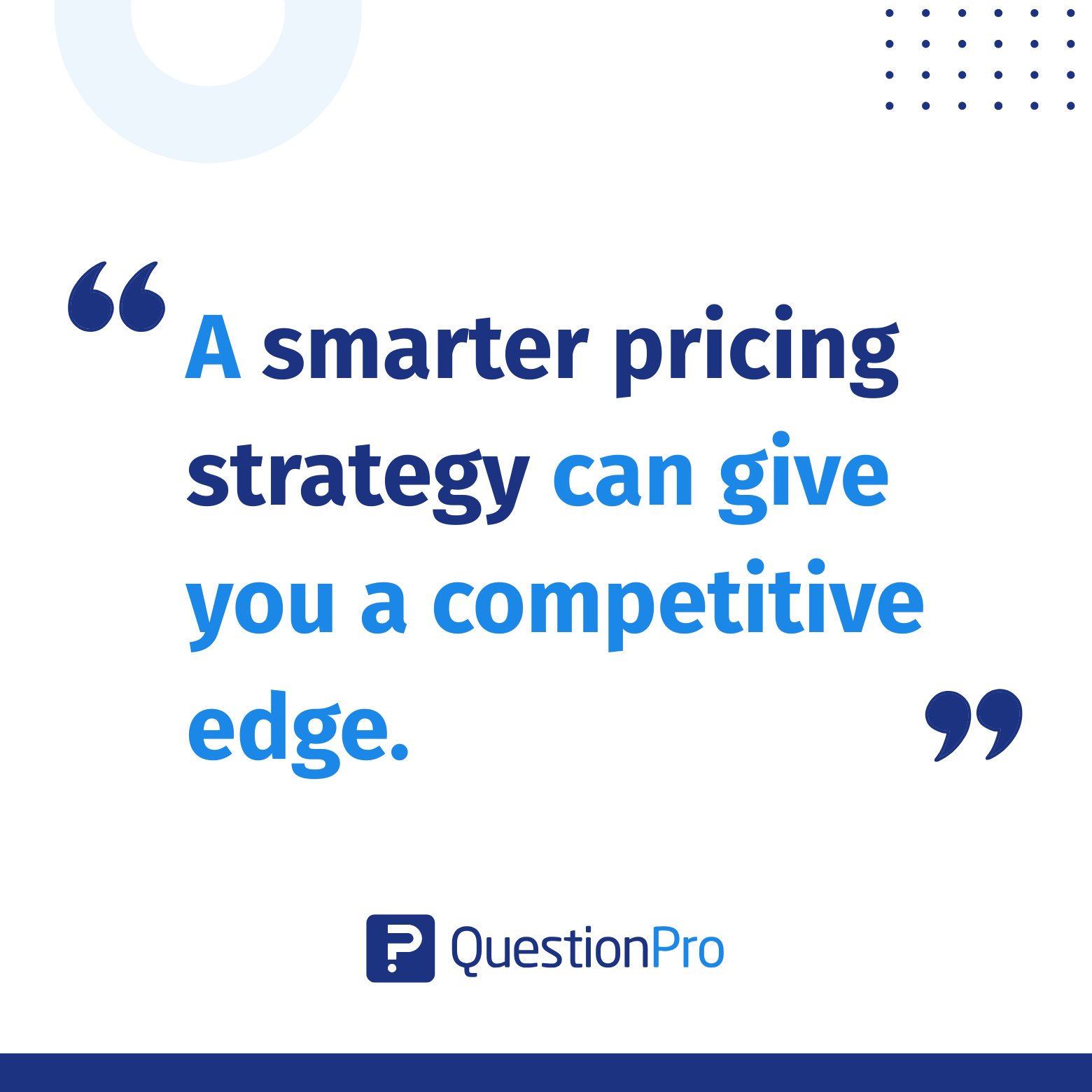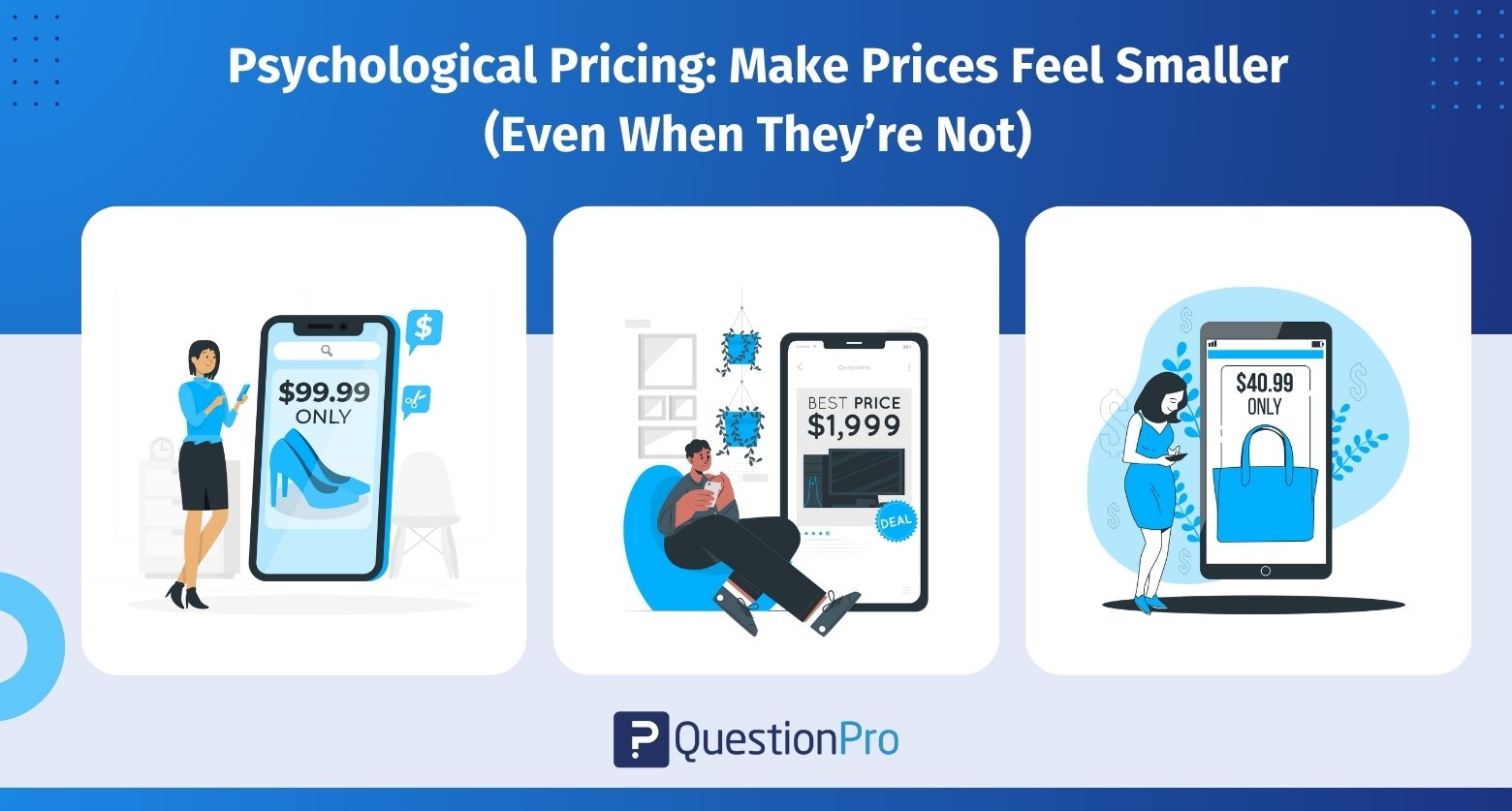
The price you set for your product or service can make or break your business. You won’t find the perfect price overnight. That’s why you need a well-thought-out pricing strategy if you want customers to buy your products without sacrificing a significant profit margin.
Setting the right price is tricky. The price you set directly impacts how customers see your brand, whether they choose you over a competitor, and how much profit you actually make. Charge too much, and you scare away customers. Charge too little, and you leave money on the table.
Some businesses make millions by charging just a few dollars per product, while others succeed by pricing high and targeting premium buyers. Ultimately, customers will only pay what they believe your product is worth.
In this blog, we’ll learn about pricing strategy and how you can use QuestionPro Survey Software to make data-driven pricing decisions that are effective in real-world situations.
What is a pricing strategy?
A pricing strategy is a way to determine the best price for your product or service using an analytical model.
The best pricing strategies are data-driven. They take into account:
- Market research
- Customer feedback
- Competitor prices
- Business goals
- Perceived value
It’s about finding the balance between what your customers are willing to pay and what makes sense for your bottom line.

When you build a pricing plan based on real market conditions and customer behavior, you’ll make better decisions, grow faster, and stay ahead of competitors. You’ll know when to charge more for premium features, when to offer discounts, and when to hold steady on your price because the value speaks for itself.
Common Types of Pricing Strategies
Different pricing strategies can help your business grow, increase sales, and maximize revenue. Businesses use different pricing strategies based on their goals, products, and market.
Here are some common types of pricing strategies to think about as part of your overall marketing plan:
1. Value-Based Pricing Strategy: Charge for What Customers Actually Care About
Not all customers buy products just because they’re the cheapest option. If they believe the product is worth it, they’re sometimes willing to pay more.
In value-based pricing, instead of setting prices based on your costs or what competitors charge, you base your price on what your customers think your product is worth.
This strategy works best when you offer something unique, whether that’s better features, premium quality, or an experience your competitors can’t match. If your product solves a real pain point or adds meaningful value to customers’ lives, you have room to charge more.
But here’s the catch: you can’t guess what customers value. You need to ask them.
2. Competitive Pricing: Stay in the Game by Watching the Market
Customers are smarter shoppers than ever before. With just a few clicks, they can compare prices across different brands and products. In fact, 96% of people compare prices online before making a purchase. That’s why competitive pricing is such a popular strategy.
With competitive pricing, you can set your prices based on what’s already happening in the market. You can match the current market rate, go slightly lower to attract bargain hunters, or charge a bit more if you offer extra value. The key is staying close enough to competitor pricing so customers still consider you an option.
This strategy works best in crowded industries, where many companies offer similar products or services. Think retail, SaaS tools, meal delivery, or even local service providers like landscapers and cleaning companies.
Before you adjust your prices, it’s important to understand how customers view your product compared to competitors.
- Do customers see your product as better, cheaper, or about the same as others?
- What features matter most to them?
- Would they pay more for certain upgrades, or do they just want the best deal?
You can maintain market share in a competitive market by offering slightly lower prices. Additionally, it is necessary to keep a close eye on average market prices to maintain a competitive edge with customers who are price-sensitive.
3. Penetration Pricing Strategy: Launch Low to Grow Fast
Breaking into a new market isn’t easy. If your business is new in the market, your customers should have a reason to choose you over other brands they already know and trust.
Penetration pricing strategy launches a product at a price much lower than competitors. The goal is to attract new customers quickly, capture market share, and establish brand awareness immediately.
Penetration pricing works well when you need fast adoption. For example, if you’re launching a new app, streaming service, or subscription product, setting a low price can tempt customers to try you out, especially if they’re price-sensitive.
It’s much easier to get into a low market than an average price, and you can get new customers quickly. It should only be used for short-term pricing, and it won’t work in the long run.
4. Psychological Pricing: Make Prices Feel Smaller (Even When They’re Not)
Psychological pricing strategy taps into basic human behavior. By making small changes to how you display prices, package products, or run promotions, you can make an offer seem more attractive.
People don’t always think rationally about price. For example:
- $49.99 feels cheaper than $50, even though it’s just a one-cent difference.
- Buy-two-get-one-free deals feel like a bargain, even if the math is the same as a bulk discount.
- Limited-time offers trigger FOMO (fear of missing out), pushing people to buy sooner rather than later.

This approach works for almost any business, but it’s especially popular in the retail, hospitality, and food service industries, where impulse buying is common and small price adjustments can drive big results.
Making small changes to your sales methods can increase sales without losing money. However, some customers may perceive it as a trick, which can potentially harm your reputation or lead to lost sales.
5. Freemium Pricing: Free to Try, Pay to Upgrade
Freemium pricing is everywhere, especially in the software world. The idea is to offer a free basic version of your product, then charge for premium features once people are hooked.
This strategy lets customers experience the value of your product before making a commitment. It removes the barrier to entry, builds trust, and gives users time to learn what your product can really do. Once they’re comfortable, many are happy to pay for more.
Freemium pricing is a great way to:
- Attract new users without heavy sales pressure
- Build brand awareness by letting people try before they buy
- Turn casual users into loyal customers over time
It’s a favorite model for SaaS companies, membership programs, and online services, where the cost of serving free users is relatively low compared to the potential lifetime value of paid subscribers.
6. Premium Pricing Strategy: Charge More, Offer More (or at Least Look Like You Do)
Sometimes, higher prices actually attract more customers, but only if they believe they’re getting something better. That’s the idea behind premium pricing. You set your prices above the market average to signal quality, exclusivity, or luxury.
Premium pricing works well if:
- You’ve built a strong brand or loyal following
- Your product is seen as innovative, high-end, or exclusive
- Your target audience cares about status, quality, or being first in line
Luxury brands, high-end tech companies, boutique services, and even fine dining restaurants often rely on this strategy.
The profit margins of this pricing strategy are higher because you can charge significantly more than your production costs. But, it only works if customers think your product is the best in quality.
How to Build a Pricing Strategy Using Customer Feedback
The best pricing strategies are built on customer insights, not guesswork. Here’s how you can create yours:
Step 1: Start by Understanding Your Customers
Before setting any prices, you need to understand what your customers are willing to pay and why. Use simple surveys to ask questions like:
- How much would you be willing to pay for this product or service?
- What features or benefits would make you pay more?
- At what price does this feel like a good deal? At what price does it start to feel too expensive?
These answers will help you find the sweet spot between value and affordability.
Step 2: Analyze the Competition
Next, take a look at how similar products are priced in your market. But don’t just copy what competitors are doing. Research how competitors price similar products, then survey customers to understand if they perceive your product as better, cheaper, or more valuable.
A survey or focus group can help you decide whether to price higher, lower, or right at the market average.
Step 3: Test Price Sensitivity
Now use pricing research tools to test how changes in price will impact customer demand. Use some of the most popular pricing research tools like:
These methods will provide you with data-backed insights instead of guesses and help you measure how price changes affect demand.
Step 4: Decide on Your Pricing Model
Once you’ve gathered the data, pick a pricing model that aligns with your business goals.
For example:
- Penetration pricing if you want fast market entry
- Premium pricing if you’re positioning yourself as high-end
- Value-based pricing if you’re focused on maximizing customer satisfaction and perceived value
Step 5: Monitor and Adjust Your Pricing Strategy
Keep testing prices after launch. Use ongoing surveys to check customer satisfaction, churn risk, and feedback about pricing fairness.
This allows you to tweak your pricing strategy over time, staying competitive while keeping customers happy.
How QuestionPro Helps You Create a Smarter Pricing Strategy
Choosing the right pricing strategy is only effective when backed by real customer insights, and that’s where QuestionPro stands out. Whether you’re launching a new product, entering a new market, or adjusting your pricing model, QuestionPro’s suite of tools helps you make data-driven pricing decisions with confidence.
Here’s how:
1. Run Pricing Surveys to Measure Willingness to Pay
QuestionPro makes it easy to measure what your customers are truly willing to pay using specialized pricing research methods like the Van Westendorp Price Sensitivity Meter and Gabor-Granger.
It simplifies pricing research with powerful features designed to gather clear customer insights:
- Multiple customizable question types (rating scales, multiple choice, open-ended)
- Intuitive survey builder for easy personalization and branding
- Robust pricing analytics for quick interpretation of pricing sensitivity
2. Test Different Pricing Models with A/B Surveys
Not sure which pricing approach works best? QuestionPro makes it simple to test. It lets you run A/B or split tests to compare different pricing models directly with your audience.
You can create multiple pricing survey versions presenting different pricing models and randomly distribute them to segments of your audience. The collected data highlights which pricing resonates most, providing solid evidence to guide your decisions.
3. Measure Customer Perception and Brand Value
Understanding how your customers view your brand is crucial, especially when using value-based or premium pricing strategies.
With QuestionPro, you can:
- Design brand perception surveys tailored to your audience
- Use sentiment analysis to uncover positive or negative associations
- Track changes in brand value over time with ongoing surveys
- Segment responses to understand perception differences by demographics or behavior
4. Segment Your Audience by Pricing Sensitivity
Different customer groups have different price sensitivities. QuestionPro lets you segment your respondents by income, region, usage, or other criteria. This segmentation helps you identify who is willing to pay more and who needs a more affordable option. Armed with these insights, you can personalize your pricing strategy to maximize revenue.
5. Collect Feedback Post-Purchase to Optimize Further
Pricing strategies should evolve based on customer experiences. QuestionPro allows you to gather feedback after purchase or cancellation to learn if pricing influenced buying decisions. These surveys reveal pricing pain points and help you refine your offers to reduce churn and increase satisfaction.
With QuestionPro, your pricing strategy doesn’t have to rely on guesswork. You gain actionable insights directly from your customers.
Conclusion
As we’ve seen, there’s no one-size-fits-all approach when it comes to pricing strategy. Different businesses have different goals, and your pricing model should support the outcomes you’re aiming for.
- Are you trying to maximize revenue?
- Do you want to capture more market share quickly?
- Are you focused on clearing inventory or testing new products?
Whatever your objective, the right pricing strategy can help you get there. The key is to stay flexible, listen to your customers, and adjust as you learn more about what works.
With QuestionPro CX and Pricing Research tools, you can collect real feedback from your audience, understand how they perceive your pricing, and discover what they’re truly willing to pay. Whether you’re experimenting with freemium models, premium positioning, or competitive pricing, customer insights will guide smarter decisions.
Ready to create a pricing strategy that actually works?
Let QuestionPro help you turn customer feedback into pricing confidence. Start today and build a pricing plan that grows your business while keeping your customers happy.
Frequently Asked Questions (FAQs)
Answer: A pricing strategy is a structured approach to setting the best price for your product or service. It helps balance customer expectations, competitor pricing, and profitability.
Answer: Pricing directly affects sales, market share, and profit. A well-planned pricing strategy helps you attract customers, stay competitive, and grow your business sustainably.
Answer: Start by understanding your business goals. Are you aiming for market penetration, maximizing profit, or positioning your brand as premium? Use customer feedback and market research to guide your decision.
Answer: Methods like the Van Westendorp Price Sensitivity Meter, Gabor-Granger model, Conjoint Analysis, and A/B price testing help you understand what customers are willing to pay.
Answer: QuestionPro’s survey and pricing research tools make it easy to collect real customer feedback, test price sensitivity, and build data-driven pricing strategies.







